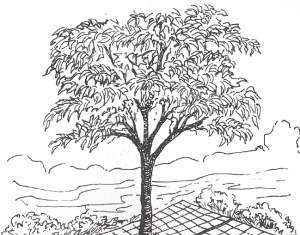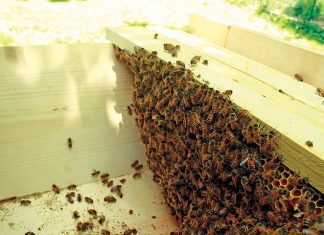(and be assured everything still
|
|
| Issue #115 • January/February, 2009 |
Back in the early 1990s the outlook for the nation in general and gun owners in particular seemed rather grim to many people. A few years earlier in 1986, Congress had banned civilians from owning newly manufactured machine guns. There was ever more strident talk of banning semi-automatic weapons or so called assault weapons. Many of us regarded a semi-automatic rifle as the foundation of a home defense battery. Many of us believed that more laws banning ever more types of guns were imminent. About that time I acquired a Ruger Ranch Rifle through a private sale. I decided to stash it away in a safe place just in case my worst fear was to materialize, another gun ban.
|
First order of business was to decide how I would prepare the gun for long-term storage and where I would store it. I decided that for maximum security I needed to bury it. This would keep it safe from all but the most determined government goons. I set about finding an appropriate location. I live in a fairly remote, wooded rural area in the northeast. One day as I was walking in the woods I noticed a hemlock tree had blown down and been uprooted by a recent windstorm. There was a small crater about eight feet across and three feet deep where the root ball had been torn out of the ground. It occurred to me that this would be a good spot for my rifle.
Since I now had the location, I began preparing the rifle for storage. I bought a piece of 6-inch diameter schedule 40 PVC pipe, end caps, and PVC solvent from a hardware store in another town where I had never done business before. Being in a rural area where everyone knows everyone I didn’t want to arouse any suspicions about what I was up to. I then disassembled the rifle and completely coated every metal part with a rust preventative oil intended for storing unused machinery in damp locations. This oil dries to form a waxy coating. I was extra careful that the bore was completely coated. I wanted to vacuum-pack the rifle as extra insurance against rust. As it turned out my employer had just taken delivery of a mainframe computer that happened to be wrapped in a large
|
aluminized mylar bag for shipping. This proved to be the perfect material for my purpose. I discovered that with a warm iron I could fuse the edges of this material into a custom-fitted airtight bag for the rifle. I placed each individual component of the partially disassembled rifle in its own custom-made mylar bag with a small bag of silica gel desiccant to absorb any moisture present. Using my shop vac and an iron I managed to produce a professional-looking vacuum-packing job. The barreled action, stock, trigger assembly, hand guard, magazines, scope, and mounts all went into individual bags.
Since the rifle was so heavily preserved I knew I would need something to degrease it with when I finally retrieved it so I included two small cans of 1-1-1 Trichlorethane in the package. Also, since a rifle is of little use without ammunition, several thousand rounds of .223 were included. Because every well-maintained rifle needs to be cleaned and oiled occasionally, I added a cleaning rod, patches, Hoppe’s #9 solvent, gun oil, grease, and owner’s manual. A set of reloading dies was included as well. If dire circumstances required me to retrieve my rifle I wanted to be sure that I would have everything at hand necessary to put it into service. All of the individually wrapped components were sealed together into a larger mylar bag custom-made for the purpose along with a couple more medium-sized bags of desiccant. A few bags of ammo were taped to the side of this bag and the entire thing was wrapped in duct tape. Additional ammo was packed into zip lock freezer bags.
|
With everything prepared I was ready to load the pipe. I first put in a large bag of desiccant followed by several bags of ammo, followed by the bag containing the rifle and supplies. Since there was some empty space surrounding the rifle, I dumped in some loose ammo just to fill the voids. More bags of ammo were then added to fill the pipe. Since I had a tank of nitrogen available, I also purged the air from the tube with the nitrogen before sealing it. This was undoubtedly overkill but I had it available so I used it. I took extreme care while using the PVC solvent to insure that the caps were perfectly sealed and watertight. Finally, I painted the pipe black, and at this point, 15 years later, I’m not sure why.
I loaded the sealed pipe in the back of my truck and drove up into the woods to the downed hemlock tree previously selected. With a post hole digger I dug a hole about six feet deep and a foot in diameter in the center of the crater left by the root ball of the tree. After gently placing the pipe in the hole, I carefully pulled the tree upright using a chain attached to my truck. By this time the tree had died and most of the needles had fallen off. Once returned to vertical it was pretty stable and a little dirt and debris shoveled around the edges did the trick. In any healthy, well-managed forest there are always a few standing dead trees, so this one would not arouse the curiosity of anyone who hunted or hiked there.
|
I never told anyone what I had done and I didn’t write down the location anywhere. About five or six years later I had a timber harvest. I had my consulting forester mark the tree as a wildlife tree so it wouldn’t be disturbed by the loggers. It was, after all, popular with the Pileated Woodpeckers. It has been 15 years since I buried the rifle and I have recently had another timber harvest. The tree was quite rotted by this time and it didn’t survive the harvest. I had been keeping an eye on it, so when it finally fell I marked a nearby tree so I could find it again after the loggers left. Even careful logging causes quite an upheaval in the forest and it can be difficult to locate a specific spot after all the landmarks have been changed. After the logging crew had left it took me several days with a shovel and a rake to locate the rifle. In hindsight, I should have had some additional way of locating it. Since the top of the pipe was about three feet below ground level, my old metal detector wasn’t much help. I decided that it would be interesting to retrieve the rifle and see how well my storage plan had worked.
I managed to locate the very rotted stump beneath the logging debris and started digging. Once I located the top of the pipe I excavated around it about a foot on all sides and to a depth of about a foot below the top of the pipe. I attached a noose of polypropylene rope and used the winch on my truck and a convenient log to slowly pull the pipe out of the ground. After all these years the soil was still very loose around the pipe and it was relatively easy to pull it out. I could have accomplished it without the winch had it been necessary. After removing the pipe, I filled the hole with logging debris and covered it up with some loose hemlock boughs to prevent someone from falling into it.
|
Back at the house I hosed off the mud and prepared to saw the pipe open. Using a handsaw, I very carefully cut completely around one of the caps. I didn’t want to damage the contents by being too enthusiastic.
With the cap removed it was immediately obvious that no moisture had gotten into the pipe. I carefully slid the contents out on to a table for examination. After unwrapping the duct tape and removing the outer bag, it was obvious that all was OK. All of the individual packages were unwrapped to reveal the contents were as good as the day they were packaged.
So if you think it is necessary, you can store a rifle safely for long periods in harsh environments. A little attention to detail, some scrounged materials, and a few dollars in supplies are all it takes.




















Only bury on property you or friend/relatives have control over.
My uncles buried a ‘time capsule’ a few blocks from their house, 6 months later a new house covered their stuff.
All they lost was some pocket change.
Location is easy. If you’re familiar with (swing ties), which is simply using two permanent spots each measured to your burial spot. Come back measure and there it is.
How long of a 6″ pipe did it take to store all that in? Thanks.
“I did this with several guns and cannot find them. Have looked over 20 days …”
Job – buy or borrow a good metal detector. Depending on how deep you buried them will dictate how sophisticated of a detector you’ll need.
Did the sale thing, but laid the pipes horizontally. 14 long guns, with ammo. Dug them up when Trump was elected for inspection. Perfect condition after 22 years… Simply placed the weapons and ammo in the pipes and sealed them in the house. Nothing else in the tubes. Buried them one foot deep and placed brush over them. Newspaper the mags were wrapped in was still dry and ammo was untarnished. Never bury a tube you can’t dig up with your hands and a pocket knife.
There are other methods to accomplish the same end. The first and most important step is to decide where to bury the pipe. Once you’ve done that, the rest is pretty easy.
Some people feel that glued-on caps at both ends is overkill, that threaded caps will work just as well and also allow access without cutting off the end of the pipe. I get the feeling they want to inspect their cache from time to time. Gluing the caps on ensures that you won’t be checking things out frequently, introducing dirt and moisture into the package. Remember, you’re doing this to be prepared for the BIG emergency. All that said, you still must keep oxidation of parts at bay until you dig the cache up and it’s best to be prepared to use the contents as soon as possible.
I tried a slightly different method and – admittedly, for a shorter time but it worked perfectly.
After carefully measuring my Chinese SKS I realized It would fit nicely inside a 6″ diameter pipe. I chose ABS pipe over PVC because it is less brittle and because it’s already black. After normal lubrication I assembled the rifle and dry-fired it a few times to be sure I hadn’t lost any parts. I then dug up several plastic 35mm film cans and drilled holes through them. Then I started putting stuff together.
First, I glued the cap on one end. This became the “bottom” of the tube and a handful of rags went in. Then came one of those film cans with a couple of oxygen absorbers in it and a couple of handfuls of loose ammo followed by a single rag to cushion the muzzle of the rifle. Now the rifle went in slowly so I could insert more ammo (in stripper clips) and film can O2-absorbers as space became available. All this was followed by more rags and the other cap was glued in place.
At the time I did all this there was no urgent push to bury my stuff to avoid confiscation so I simply tossed the sealed tube into a pile of similar scrap pipe behind my garage. It laid there in the rain for a year before my curiosity got the better of me. I knew where to saw to avoid anything valuable and when I finally broke through the wall of the tube I heard a distinct ‘his-s-s’ as air went INTO the tube. Oxygen comprises about 16% of our atmosphere and it had been tied up with O2-absorbers!The rifle worked perfectly and AFAIK it still does.
If anyone is concerned about getting the tube open they should consider fire: Heat the end of the tube (remember the rags?) until the plastic softens enough to cut away with a knife. It might require several visits to the fire with the subsequent whittling to get the job done but if you really need the rifle it’ll be worth it. If starting a fire isn’t a good idea then using an asphalt road as a huge file will also work – slowly.
I’m too old to be much help in a shooting war but young enough to hope all these preparations are unneeded. Merry Christmas and Happy New Year!
No access to Nitrogen? Go find some Dry Ice. Drop inside tube and let it evaporate. It will force the air out.
I’m surprised at some of the snarky, know-it-all comments that people have made here. “overkill”, really, it worked didn’t it? Followed by, “if I did this” tells me all I need to know. You haven’t done this, but you’re such a know-it-all you sit there on your fat ass second guessing what was done and what worked. You’re so damn lazy you won’t even start digging a hole. Criticism for a guy who tried and succeeded at this is ridiculous. If some of you know-it-all’s are so damn smart why haven’t you done some long term storage and then written a similar article? I’ll tell you why, because you’re not smart enough to know how to do it, and furthermore you’re not willing to risk ruining a rifle trying to do a long term storage because deep down inside your pea sized brain you doubt that your method of storage will work.
Note to Harlan, thanks for the idea about the threaded cap sealed in grease. Maybe marine grade grease?
Kudos to Mr. Wood for trying to educate a few morons.
@bigcitynights
Why are you asking the author what you are supposed to do?
He’s just posting his experience for anyone who’s interested.
Solve your own problems you metro-child.
You may not be able to bury it but why not hide it? Does your work bench need a new leg or legs? The shed walls may need attention. Get creative.
I’m partially with Beau that I like my guns close but a have safe queens that haven’t been touched in over a decade. Considering you can buy a functional AR15 for under $400 we should all store more than one. Store one like this, store one that’s all intact and have a few close but not at home. Watch the videos about confiscating guns during Katrina in New Orleans if you want your blood to boil. Think about it, we all buy gas and vehicles that are way more than what we need to put this in perspective. The idea that we can’t afford two extra guns and ammo just to bury is a cop out. Stop listening to her and go buy your extra stuff.
Yeah this all works fine and dandy for those of you who live in, or near remote areas like that. But not so good for those of us who live in larger cities and such.
Where the fuck are we supposed to bury things? Cant take a shovel and dig in cement. And I sure as hell wouldn’t bury anything in some public park. So what are we supposed to do then?
Mongo never bury his gun he wants it ready when Beto comes.
Great article and read. Suggestion on location; use your phone to determine the exact GPS coordinates and then record them somewhere in coded fashion. If you’re paranoid, and it’s good to be so, use a burner phone to acquire the GPS coordinates never your own phone. Never take your Cell phone with you on any clandestine excursion. It automatically tracks and records your movements. Big brother may not be actively tracking you but guaranteed they can go back to historical records and run a search.
If you’re too lazy to go to the trouble of making your own burial tube, you can find them here: Etsy.com/shop/DadMakesStuff This guy sells a few different sizes for just a few bucks over what you’ll spend at the hardware store for materials.
I did this with several guns and cannot find them. Have looked over 20 days. Shit
Definitely a good idea as you live in Yankee Land. Your gun rights are not long for this earth. Land of Cuckolds > Mason Dixon Line!
Instead of gluing on both ends glue one end with one that has the threaded screw in and use a heavy grease or Vaseline & screw it in tight no water should get in.
Overkill in the burial, but effective, IMO. If I did this, it would be a quick retrieval burial, and the gun would be ready to load an fire upon retrieval. Having to put your rifle together if you’re pressured might not be a good idea, but then again you may be good at that sort of thing.
My biggest problem would be finding it later. I have a bad memory for such a location, and would need not only written directions of the location, but some visual cues nearby. How would you have opened the pipe in the outdoors without your tools, if needed? I would leave on end of the pipe unglued so I could hopefully remove it by hand in the field. When I think of hiding my weapons, I feel a sense of urgency if I have to retrieve them, and would want to have them ready for use as soon as I dug them up. I got several good ideas from you example, and actually had planned the exact same thing for my Ruger Mini-14. I also wanted to bury 2-3 handguns with ammo, and some supplies in separate places inside sealed ammo cans. My problem is I hate to be separated from my guns at all, but it may become necessary someday.